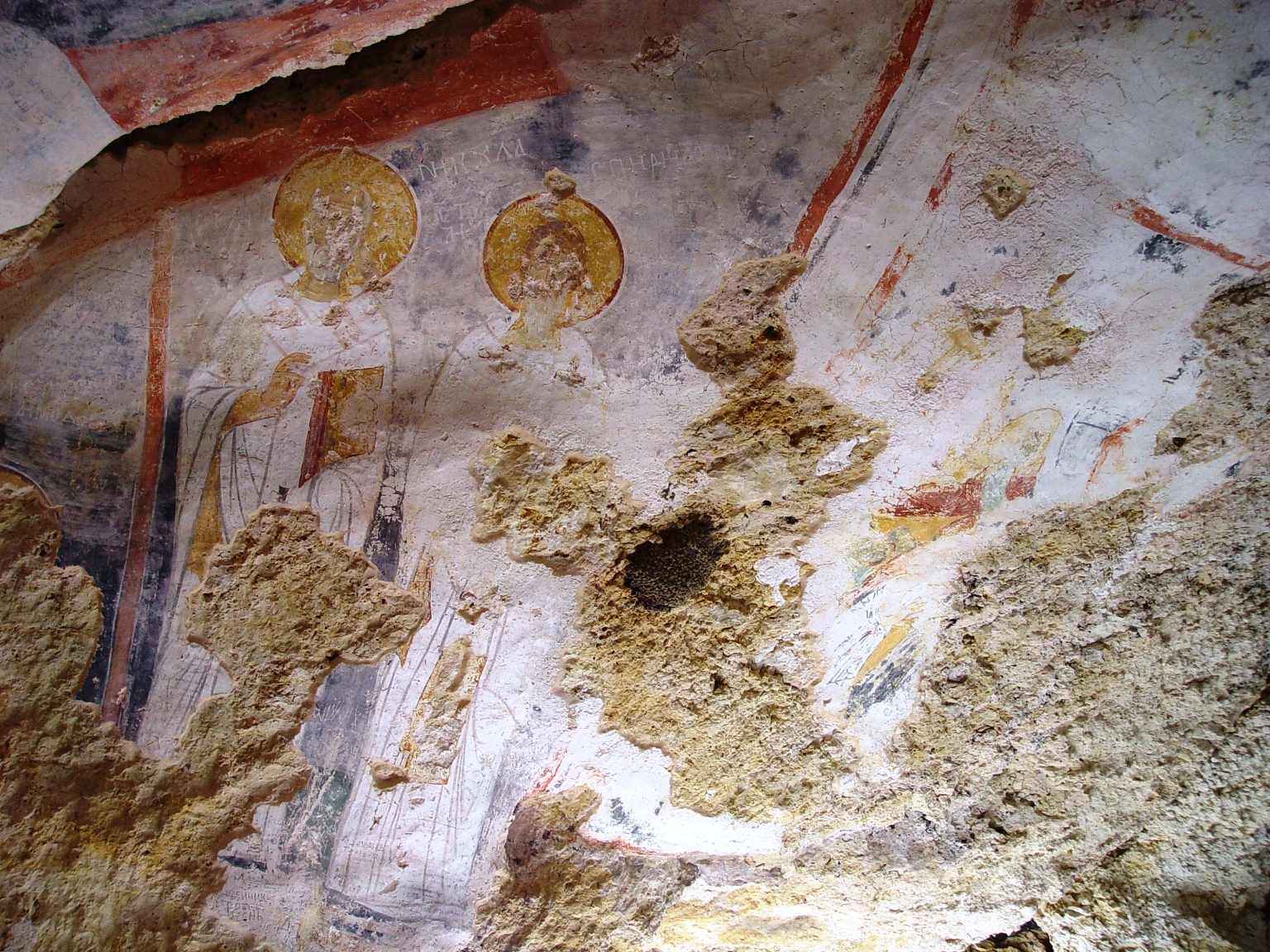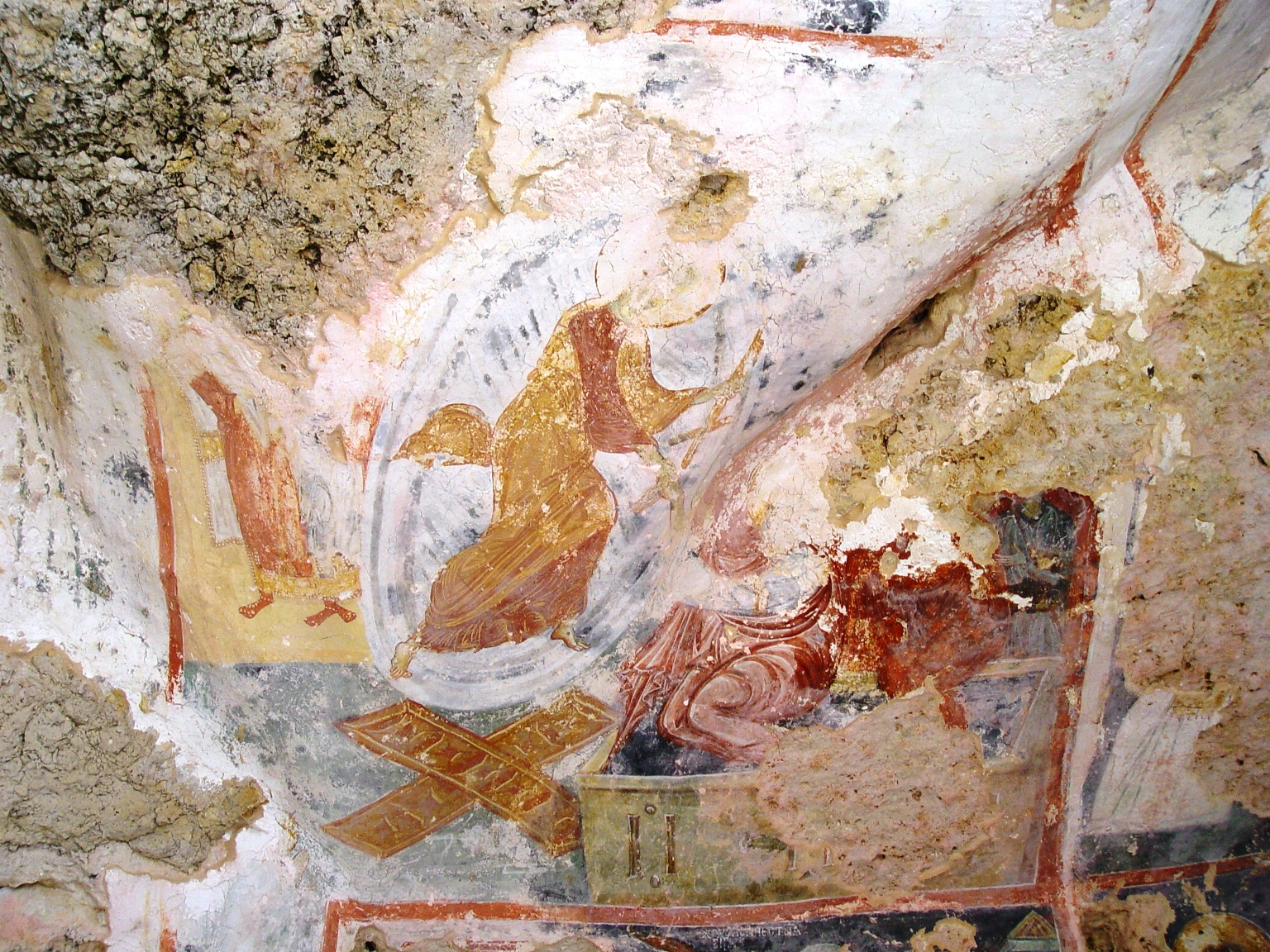
Reserved Area
Artists - ArtWorks
Frescos of the Ivanovo Rock-hewn Churches
 Bulgaria
BulgariaByzantine art - Paleolog style
The frescos at the Ivanovo Rock-hewn Churches – the church in God’s gorge, dated as the oldest of all monuments in that area. This church set the beginning of the monk-community – the authors were monks /hermits, hesychasts/ – who have taken a solemn pledge of silence
According to professor Assen Vassilev the frescos in God’s gorge are from the XII century. They are not precisely dated.
Byzantine art – the predecessor of the Paleolog style – the 3rd and last independent development stage, called Third Renaissance. This style originated from Nicaea after the restoration of the Byzantine empire during the reign of the Paleologs 1241 – 1453. The Bulgarian art of that time gravitates towards the powerful Byzantine culture. In character these frescos are in the Byzantine style of that epoch, but the unknown monk-artists have managed to express their pursuit of national interpretation. The Bulgarian art of that period continues the traditions of the art of the first Bulgarian kingdom. Byzantium dominates in the life of Bulgaria despite the short periods of relative independence of the Bulgarian rulers of that period.
The artist’s remain with the mediaeval understanding of art: when he treats an object /a figure or landscape/, he uses canonized artistic expressions. Despite the flatness of the paintings, an approach inherited from the previous canonistic Byzantine manner, the frescos demonstrate a reversion to the Hellenistic traditions. The inscriptions on the frescos are in Bulgarian language.
The church in God’s gorge is the oldest from the complex of rock-hewn churches in Ivanovo. It is an additionally carved by monks cave with size 3,5 X 5 meters and has been painted in alfresco style /wet fresco/. The ceiling is similar to a vault while the surface of the walls is uneven. The frescos on the vault are best preserved – just like all the rest they also carry inscriptions in Bulgarian. On the ceiling can be found the “Mandilion” and “Keramidion”, i.e. Christ Ubrus and St. Keramida. Further to the east are the large figures of St. Nikola and St. Spiridon – with white garments, long bodies, large clothing folds, which additionally underlines monumentality. The colors are exquisite, the pale-pink faces of the saints are modeled with touches of very carefully graded brown and green. The frescos are done in deep colors. The careful placing of the paints in order for good harmony to be achieved is quite distinct. The large composition “Descent into Hell”, which is also presented on the vaulted ceiling, has archaeic iconography. Above the smashed gates of Hell with a large and bright halo is presented Christ while pulling Adam from the casket. Christ is presented in strong motion. His garment emphasizes the direction of the motion, the hiton flutters and intensifies the dramatics of the scene. In the remaining compositions “Assumption”, “Ascension of Christ”, which are very badly preserved, is visible the main tonality.
Since the rock-hewn churches at Ivanovo as well as monastic complex have been created, maintained and inhabited by monks hesychasts, who have taken a solemn pledge of silence and have retreated voluntarily from life /this is a closed community/, no transnational influences can be found. In addition to this it is a fact that all the inscriptions on frescos are in Bulgarian.
The authors of the frescos at Ivanovo are unknown – this is probably related to the solemn pledge of the monks. The complex had been actively inhabited for approximately 4 centuries by the monk hesychast community, during which time there is an upheaval in the achievements related to the wet fresco used by the artists in the different monuments preserved here.
Characteristic for this period from the development of Bulgarian art is also the anonymousness of the artists.
A UNESCO work of art; the frescos have strong artistic, style and iconographic characteristics, which make them one of the brightest monuments of mid Middle Ages. Other reasons for this selection are also the following artistic, stylish and iconographic marks – the appearance of clearer three-dimensional images, the architectural and natural forms become spacey, the figures are sized in accordance with the environment and are presented in motion, there is a strive for presenting the anatomy of the figure. The character of the image is changed – the dramatic beginning is emphasized. The ways and techniques of decorating are changing.
Encyclopedia of visual arts in Bulgaria, volume. ІІІ, S – Z. Sofia, Bulgarian academy of sciences, issue of “Marin Drinov” publishing house, 2006, page 28.
History of Bulgarian fine arts. volume 1. Sofa, Bulgarian academy of sciences, 1976.
A. Vasilev, “The murals at Ivanovo”, 1953.
Monasteries in Bulgaria: An album. - Sofia: Spectrum, 1994.
http://www.bulgarianmonastery.com/ivanovo_monastery.html
http://en.wikipedia.org/wiki/Rock-hewn_Churches_of_Ivanovo
Related Material:
Image available

File name: 15_XII 1.JPG
Description of the material:
Murals from the church in God’s gorge.
Contextualisation Of the source:
The image is provided by the Regional museum of history in Rousse.
Interpretation of the source:
The large figures of St. Nikola and St. Spiridon – with white garments, long bodies, large clothing folds, which additionally underlines monumentality. The colors are exquisite, the pale-pink faces of the saints are modeled with touches of very carefully graded brown and green. The frescos are done in deep colors. The careful placing of the paints in order for good harmony to be achieved is quite distinct.

File name: 15_XII 2.JPG
Description of the material:
Murals from the church in God’s gorge.
Contextualisation Of the source:
The image is provided by the Regional museum of history in Rousse.
Interpretation of the source:
The large composition “Descent into Hell”, which is presented on the vaulted ceiling, has archaeic iconography. Above the smashed gates of Hell with a large and bright halo is presented Christ while pulling Adam from the casket. Christ is presented in strong motion. His garment emphasizes the direction of the motion, the hiton flutters and intensifies the dramatics of the scene.
Comments about this Artist/ArtWork
Michelangelo - Copyright 2008 - This project has been funded with support from the European Commission